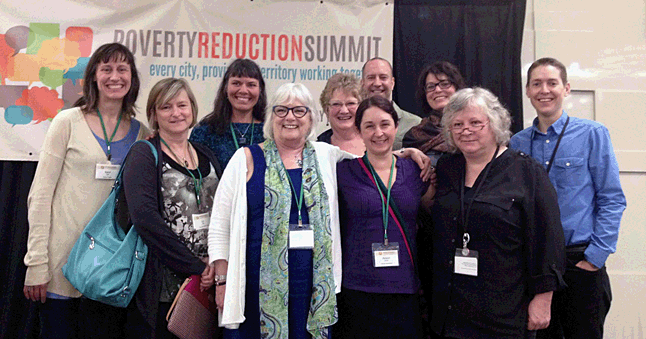
By David F. Rooney
Back from Ottawa where she attended a national conference on poverty reduction last month Jill Zacharias has concepts like the living wage proposal and new approaches to economic and social development foremost on her mind.
“There are over 3 million people in Canada living in poverty,” the City’s social development coordinator said in an interview after her return form the National Poverty Reduction Summit. “Over one million of them are children. In the last few years, since 2007, our standard of living in Canada has decreased by 12 per cent. Income disparity is increasing so the gap between those who have and those who do not is getting significantly bigger. So what that does is it increases the social isolation and marginalization of very low-income people in our country.”
If you own a house, have a secure job with a good income and have a reasonable expectation of watching your children become well educated and build careers of their own it may be easy to imagine that poverty is not a major issue in our community. However, it is and she’s right: there is more of it now than there was, say, 10 or 15 years ago. Just looking at the number of people who use something as now-mundane as the Community Connections Food Bank will tell you that. Last month 417 local households utilized the food bank; 764 people visited it and there were 155 children’s visits. In 2011, 335 local people used it and way back in 2002 about 100 people used it.
“You look at the number of children and think of them this way: That’s four classrooms worth of kids who depend on the food bank every month,” says Patti Larson, Community Connections’ Community Outreach Director and Food Bank Manager.
But there are other indicators that are less well known and, when you learn about them, really somewhat disturbing.
“One thing that really jumped out at me was a study of the incidence of low birth rates in… Hamilton, Ontario, and… found that in specific low-income neighbourhoods was lower than sub-Saharan Africa,” Zacharias said. “People who are low income have a life expectancy in Canada of just 65 years of age. For everyone else it’s like 84. Twenty per cent of our health care budget is spent on diseases that are embedded in and are a direct result of poverty.
“There was this incredible sense at the summit that it’s time to create healthy communities. We all have the same motives. We all want to live in healthy communities, nice communities, livable communities and we all want a strong economy… poverty reduction is directly related to that. Poverty is like a drag on a community and its economic development.”
Zacharias said she believes Canadian society was constructed in a way that allows the continued existence of poverty.
“If we can construct a society that permits poverty we can deconstruct it, too,” she said.
That may well be, but eradicating poverty requires cooperation and idea sharing on a local, regional, provincial and national basis. Jill made a lot of valuable connections not just with development specialists in the East but right here in the Kootenays, too.
She spoke about our community’s experience and its efforts to reduce the impact of poverty (Please click here to read her Poverty Reduction Implementation Summary.), brought a video that featured local people talking about community engagement (Please activate the YouTube player at the end of this story to view the video.)and samples of art work by local school children (Please see the photo at the bottom of this story.) that illustrate their impressions of what’s important to our community.
It remains to be seen how all of this will play out over the next few years but Revelstokians are no strangers to tackling major economic, social and cultural projects. We’ll see what develops, won’t we?



